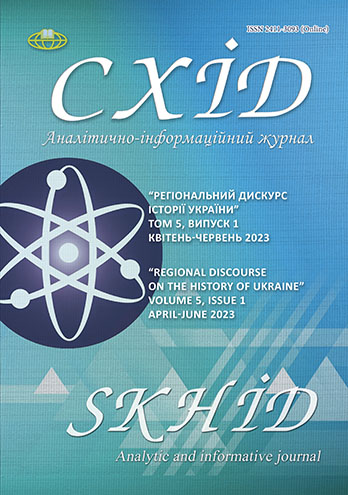Construction of regional myths: a case study of the Greeks of the North Azov Sea region
DOI:
https://doi.org/10.21847/2411-3093.2023.5(1).283081Keywords:
The North Azov Sea region, the Greeks, regional history, historical myth, Mariupol, mythological imageAbstract
The article examines the process of constructing the mythological image of the Russian Empire as a "saviour of Christians" who were resettled from the Crimean peninsula to the North Azov Sea region, which became the basis for the formation of a historical myth in the region. The paper uses the analysis of various sources: orders, letters, reports, rescripts, descriptive and statistical materials, messages, etc. to consider the main stages of creating and maintaining this image and its articulation at different levels. The author proves that the positioning of Russia's special mission to protect the Christian population of the peninsula began from the moment the Russian Empire decided to resettle Christians from the territory of the Crimean Khanate. The Russian Empire assumed a leading role in the protection of “co-religionists” justifying themselves by unbearable religious oppression and the difficult situation of the Greeks, Armenians, Georgians and all those who practiced Orthodox Christianity in a Muslim state. To strengthen its role and emphasize the importance of its “mission” the Russian Empire created and spread the image of the Crimean Khanate as a despotic state that oppressed the Christian population in every possible way and limited their religious and social rights almost to the point of destruction. Their extremely difficult situation forced the Crimean Christians to appeal to the Russian Empress to resettle them on the territory of the Orthodox Empire. This was the official version of the resettlement of the Christians used at all levels and became the basis for the construction of the myth.
The official image of the empire as the “savior” of the Christians was actively spread at first through the works of priests and representatives of the church. The special role of the leader of the Crimean Christians – Metropolitan Ignatius of Gotfey and Kafay was constructed. His actions are compared with the actions of the Old Testament Prophet Moses. In the second half of the 19th and early 20th centuries, this image was replicated by educators, doctors, and researchers of history. At this stage, the author observes the fixation of the official image of the Russian Empire as the “savior” of Christians. It was inconsistent with the memories of the Greeks and their descendants who survived the resettlement and strove to return to the Crimean Peninsula. At the same time, the “logical chain” of the regional myth about the founding of Mariupol by Metropolitan Ignatius and the first commemorative practices in his honor was built. All this laid the foundation for the final formation of the myth of the imperial city of Mariupol.
Downloads
References
Ahonen, Sirkka. (2020). The construction and deconstruction of national myths. A study of the transformation of Finnish history textbook narratives after World War II. European politics and society, Abingdon, 2020, Vol.21 (3), p.341-355.
Kalakura, Ya. (2021). Demifolohizatsiia postatei totalitarnykh rezhymiv u konteksti dekomunizatsii ta dekolonizatsii ukrainskoi istoriohrafii. Demifolohizatsiia istorii ta tvorennia mifiv v ukrainskii nautsi ta publichnomu prostori : kolektyvna monohrafiia. Lviv-Torun, Liha-Pres, 21-41. (In Ukrainian).
Lastovskyi, V. (2021) Naukova mifolohizatsiia istorii Cherkashchyny ta problemy yii podolannia. Demifolohizatsiia istorii ta tvorennia mifiv v ukrainskii nautsi ta publichnomu prostori : kolektyvna monohrafiia. Lviv-Torun, Liha-Pres, 184-197. (In Ukrainian).
Nahorna, L. P. (2008). Rehionalna identychnist: ukrainskyi kontekst. Kyiv, 405 рр. (In Ukrainian).
Ortmann, Stefanie. (2018). Beyond Spheres of Influence: The Myth of the State and Russia’s Seductive Power in Kyrgyzstan. Geopolitics, Volume 23, Issue 2, 404-435.
Rostetska, S. I. (2019). Rehionalnyi mif yak zasib formuvannia rehionalnoi identychnosti. Rehionalni studii. № 17, 46–50. (In Ukrainian).
Sidorova, K. (2012). Vytoky ta rozvytok donetskoho rehionalnoho mifu. Filosofiia ta politolohiia v konteksti suchasnoi kultury, 2(4), 222-229. (In Ukrainian).
Taranenko, O. (2015) Proiavy mifolohii spozhyvannia v sotsialnii mifolohii Donbasu. Dialoh, vyp. 20, 225-238. (In Ukrainian).
Udod, O. (2021). Istorychna nauka yak faktor demifolohizatsii istorychnoi kultury: prostir mas-media i sotsialnykh merezh. Demifolohizatsiia istorii ta tvorennia mifiv v ukrainskii nautsi ta publichnomu prostori : kolektyvna monohrafiia. Lviv-Torun, Liha-Pres, 7-20. (In Ukrainian).
Usitalo, Steven A. (2013). The Invention of Mikhail Lomonosov. A Russian National Myth, Boston, Aca-demic Studies Press, 240 p.
Vermenych, Ya. (2007). Nova lokalna istoriia ta istorychna rehionalistyka: eksplikatsiia terminiv. Rehionalna istoriia Ukrainy, Kyiv, Instytut istorii Ukrainy NAN Ukrainy, Vyp. 1, 13-28. (In Ukrainian).
Yakovenko, N. (1998). Kilka sposterezhen nad modyfikatsiiamy ukrainskoho natsionalnoho mifu v istoriohrafii. Dukh i litera. № 3-4, 113-124. (In Ukrainian).
Zashkilniak, L. (2015). Radianski istorychni mify v suchasnii ukrainskii istoriohrafii: «stare vyno v novykh mikhakh». Svitlo y tini ukrainskoi radianskoi istoriohrafii, Kyiv, 17-31. (In Ukrainian).
Downloads
Published
How to Cite
Issue
Section
License
Copyright (c) 2023 Світлана Арабаджи

This work is licensed under a Creative Commons Attribution-NonCommercial-NoDerivatives 4.0 International License.
1. Authors bear responsibility for the accuracy of facts, quotations, numbers and names used.
2. Manuscripts are not sent back.
3. The publisher does not always agree with the authors' opinion.
4. The authors reserve the right to authorship of the work and pass the first publication right of this work to the journal under the terms of a Creative Commons Attribution-NonCommercial-NoDerivatives 4.0 International License. This license allows others to distribute (copy) the published work for non-commercial purposes, provided there is mandatory attribution to its authors and a link to the first publication in our journal.
5. The authors have the right to conclude separate supplement agreements that relate to non-exclusive work distribution in the form in which it has been published by the journal (for example, to upload the work to the online storage of the journal or publish it as part of a monograph), provided that the reference to the first publication of the work in this journal is included.

